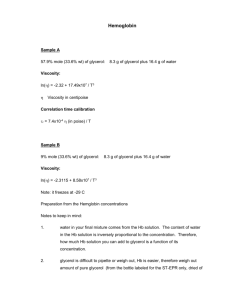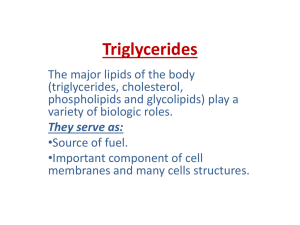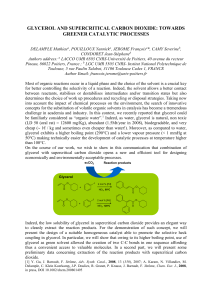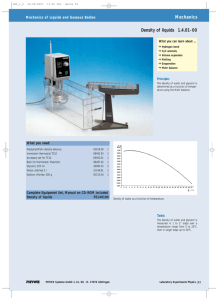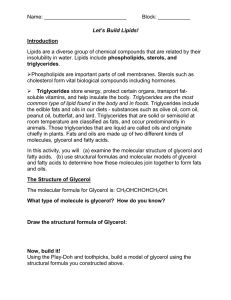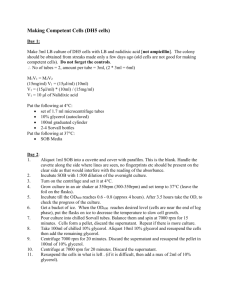Research Journal of Applied Sciences, Engineering and Technology 4(8): 869-876,... ISSN: 2040-7467 © Maxwell Scientific Organization, 2012
advertisement
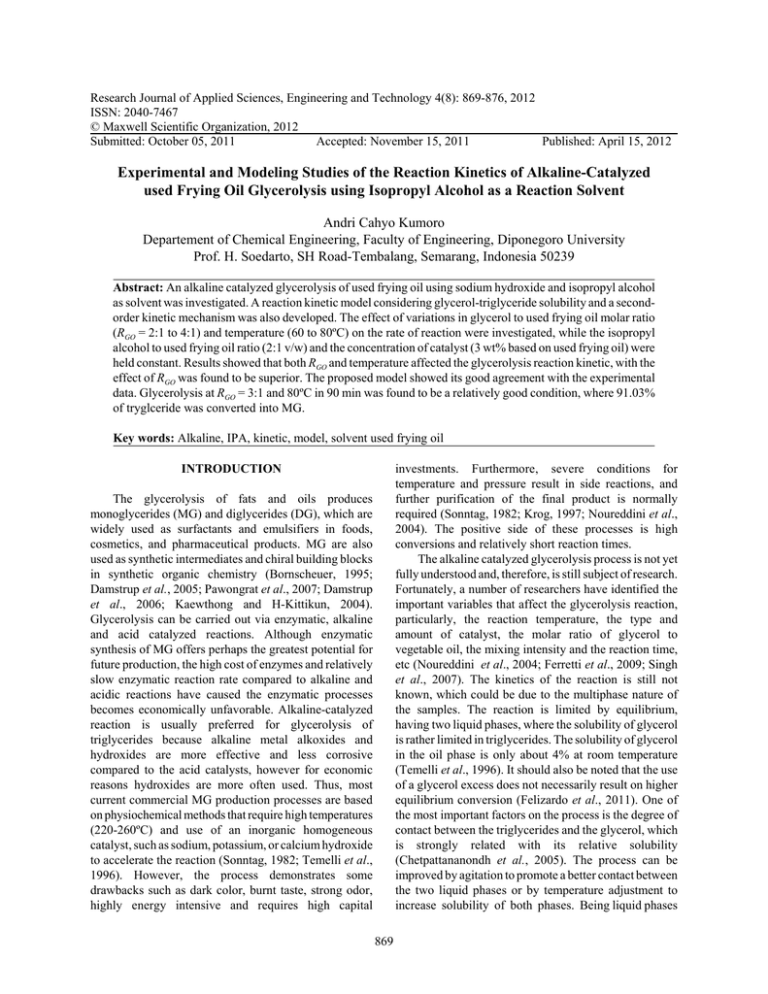
Research Journal of Applied Sciences, Engineering and Technology 4(8): 869-876, 2012 ISSN: 2040-7467 © Maxwell Scientific Organization, 2012 Submitted: October 05, 2011 Accepted: November 15, 2011 Published: April 15, 2012 Experimental and Modeling Studies of the Reaction Kinetics of Alkaline-Catalyzed used Frying Oil Glycerolysis using Isopropyl Alcohol as a Reaction Solvent Andri Cahyo Kumoro Departement of Chemical Engineering, Faculty of Engineering, Diponegoro University Prof. H. Soedarto, SH Road-Tembalang, Semarang, Indonesia 50239 Abstract: An alkaline catalyzed glycerolysis of used frying oil using sodium hydroxide and isopropyl alcohol as solvent was investigated. A reaction kinetic model considering glycerol-triglyceride solubility and a secondorder kinetic mechanism was also developed. The effect of variations in glycerol to used frying oil molar ratio (RGO = 2:1 to 4:1) and temperature (60 to 80ºC) on the rate of reaction were investigated, while the isopropyl alcohol to used frying oil ratio (2:1 v/w) and the concentration of catalyst (3 wt% based on used frying oil) were held constant. Results showed that both RGO and temperature affected the glycerolysis reaction kinetic, with the effect of RGO was found to be superior. The proposed model showed its good agreement with the experimental data. Glycerolysis at RGO = 3:1 and 80ºC in 90 min was found to be a relatively good condition, where 91.03% of tryglceride was converted into MG. Key words: Alkaline, IPA, kinetic, model, solvent used frying oil investments. Furthermore, severe conditions for temperature and pressure result in side reactions, and further purification of the final product is normally required (Sonntag, 1982; Krog, 1997; Noureddini et al., 2004). The positive side of these processes is high conversions and relatively short reaction times. The alkaline catalyzed glycerolysis process is not yet fully understood and, therefore, is still subject of research. Fortunately, a number of researchers have identified the important variables that affect the glycerolysis reaction, particularly, the reaction temperature, the type and amount of catalyst, the molar ratio of glycerol to vegetable oil, the mixing intensity and the reaction time, etc (Noureddini et al., 2004; Ferretti et al., 2009; Singh et al., 2007). The kinetics of the reaction is still not known, which could be due to the multiphase nature of the samples. The reaction is limited by equilibrium, having two liquid phases, where the solubility of glycerol is rather limited in triglycerides. The solubility of glycerol in the oil phase is only about 4% at room temperature (Temelli et al., 1996). It should also be noted that the use of a glycerol excess does not necessarily result on higher equilibrium conversion (Felizardo et al., 2011). One of the most important factors on the process is the degree of contact between the triglycerides and the glycerol, which is strongly related with its relative solubility (Chetpattananondh et al., 2005). The process can be improved by agitation to promote a better contact between the two liquid phases or by temperature adjustment to increase solubility of both phases. Being liquid phases INTRODUCTION The glycerolysis of fats and oils produces monoglycerides (MG) and diglycerides (DG), which are widely used as surfactants and emulsifiers in foods, cosmetics, and pharmaceutical products. MG are also used as synthetic intermediates and chiral building blocks in synthetic organic chemistry (Bornscheuer, 1995; Damstrup et al., 2005; Pawongrat et al., 2007; Damstrup et al., 2006; Kaewthong and H-Kittikun, 2004). Glycerolysis can be carried out via enzymatic, alkaline and acid catalyzed reactions. Although enzymatic synthesis of MG offers perhaps the greatest potential for future production, the high cost of enzymes and relatively slow enzymatic reaction rate compared to alkaline and acidic reactions have caused the enzymatic processes becomes economically unfavorable. Alkaline-catalyzed reaction is usually preferred for glycerolysis of triglycerides because alkaline metal alkoxides and hydroxides are more effective and less corrosive compared to the acid catalysts, however for economic reasons hydroxides are more often used. Thus, most current commercial MG production processes are based on physiochemical methods that require high temperatures (220-260ºC) and use of an inorganic homogeneous catalyst, such as sodium, potassium, or calcium hydroxide to accelerate the reaction (Sonntag, 1982; Temelli et al., 1996). However, the process demonstrates some drawbacks such as dark color, burnt taste, strong odor, highly energy intensive and requires high capital 869 Res. J. Appl. Sci. Eng. Technol., 4(8): 869-876, 2012 Fig. 1: The experimental set-up catalyzed glycerolysis reactions (Elfman-Bo(rjesson and Ha(rro(d, 1999; Kaewthong and H-Kittikun, 2004; Pawongrat et al., 2008). From an industrial point of view, reactants miscibility and operation feasibility are some of the parameters to be considered in selecting appropriate solvent systems for glycerolysis reactions (Zhong et al., 2009). The use of solvents having low melting point would increase the feasibility of industrial MG synthesis, because they have low risk of crystallization that makes their recovery can be done easily. Aliphatic alcohols are therefore good choices as they are able to dissolve glycerol and triglyceride to form a pseudo-homogeneous solution. The critical solution temperatures for the ethanol, n-propanol and isopropyl alcohol are 70, 60 and 50ºC. Isopropyl alcohol is likely to be the best diluent to be used as it has the lowest critical solution temperatures. Above the critical solution temperatures, triglycerides dissolve freely in isopropyl alcohol. The use of isopropyl alcohol as a diluent enables glycerolysis of triglycerides to be carried out at lower temperature that may avoid side reactions to occur. Furthermore, solvents having melting point below 15ºC and temperature range between the melting and boiling points of at least 65ºC can be considered to be sufficient for practical operations (Gandhi et al., 2003). In addition, isopropyl alcohol has the potential to remove toxic, carcinogenic, and antinutritional factors, thereby improving the quality of the products and increasing its economic value (Kuk and Hron, 1998). Side reactions are likely to occur when glycerolysis is carried out at higher temperatures. Unfortunately, at low temperatures, glycerol and the oil are almost immiscible. In addition, low reaction temperature also leads to high viscosity of the reaction mixture which subsequently decreased mass transfer and the overall Fig. 2: The Schematic Diagram of the glycerolysis reaction with rather different densities, any temperature increase of the reaction will result in increasing mass transfer in the phase containing triglycerides to the glycerol phase and increases solubility of both phases, which finally increase the reaction rate (Chetpattananondh et al., 2005). Although monoglycerides are the main product of the reaction, but diglycerides and triglycerides are also present in the reaction chamber. Shortly after reaction is completed, the reaction mixture should be cooled in order to prevent any reversion of monoglycerides. Other possible efforts in enhancing the conversion of alkaline glycerolysis of triglycerides into MG and DG is introduction of reaction diluent, such as organic solvents to improve the solubility of the reactants and reduce mass transfer limitation (Kaewthong et al., 2005). Pure solvents, like tert-butyl methyl ether (MTBE), tert-butanol (TB) and tert-pentanol (TP), or binary mixtures of nhexane with TB or TP, are quite beneficial for lipase catalyzed MG synthesis (Kaewthong et al., 2005; Bellot et al., 2001; Pawongrat et al., 2008). Some other solvents like isooctane, acetone, or binary mixtures of acetone and isooctane have been shown to be useful in lipase870 Res. J. Appl. Sci. Eng. Technol., 4(8): 869-876, 2012 reaction rate. The basic idea of this present study was to make glycerolysis of used frying oil could be done at low temperature without worry of solubility mass transfer limitations. The objective of this research was to investigate kinetic for the production of MG and DG from used frying oil in an alkaline catalyzed glycerolysis batch system with the presence of isopropyl alcohol as diluent. The molar ratio of glycerol to used frying oil and process temperature were the variables investigated in this study. The development of a reaction kinetic model was another objective of this work. to a freezer before sending them for HPLC analysis. The reaction was terminated after 2 h. Effect of temperatures (60, 70 and 80ºC) and glycerol/used frying oil molar ratios (2:1, 3:1 and 4:1) was investigated in this study. Analysis: The HPLC system with a pump (model 2350, ISCO, Lincoln, NE) and a refractive index detector (Refracto Monitor IV; Thermo Separation Products, Riviera Beach, FL) was used to analyze the products. A Spherisorb ODS 2 column (250! 4.6 mm, 80 mm pore size, 5 mm particle size; Waters, Milford, MA) was used for the separation. The temperature of the column was maintained at 35ºC by a Brinkman RC 6 temperature bath (Westbury, NY). The mobile phase for the system was a 50:50 v/v mixture of acetone and acetonitrile and was degassed before use in the system. The mobile phase flow rate was set to 0.7 mL/min. Data collection and analyses were performed using Hewlett-Packard (Wilmington, DE) Chemstation software. Before injection, samples were carefully handled with slight warming and gentle agitation to avoid phase separation. The components measured by HPLC comprised MG, DG, and TG. Standard compounds for MG, DG, and TG were used to establish the calibration curves, which later were used to quantify the content of the respective components in the samples. All analyses were done in triplicates. Reaction conversion to MG and DG was calculated on the basis of the whole content of monoacylglycerols and diacylglycerols in the analyzed sample and on the reaction stoichiometry. On the basis of previous works with the system investigated, experimental uncertainties were found to be less than 5% in terms of MG and DG conversions. All experiments were conducted in the Basic Chemical Engineering Research Laboratory of Diponegoro University, Semarang-Indonesia in the first quarter of 2011. EXPERIMENTAL METHODS Materials: Used frying oil was provided by IRT. Ibu Pudji-Ungaran, Indonesia. The oil was bleached using activated carbon (oil: activated carbon mass ratio was 4:1) at 60oC for 2 h prior to use in this work. The average molecular weight of the oil was calculated from saponification number measured according to AOCS Method Ca 5a-40 (Firestone, 1993), and was determined to be 843 g/mol. The chemicals used in this present study were procured from different sources. Sodium hydroxide (98.4 % w/w) was obtained from Fisher Scientific Company (Fair Lawn, NJ). The standards for the glycerides (99% w/w), isopropyl alcohol (99% w/w) and sulfuric acid (99.99% w/w) were obtained from SigmaAldrich Pte. Ltd. (Singapore). HPLC-grade solvents, acetone (99% w/w), acetonitrile (99% w/w), and glycerol (99.8% w/w) were obtained from Mallinckrodt Baker, Inc. (Phillipsburg, NJ). Equipments: The experimental set-up is depicted in Fig. 1. The glycerolysis reaction was performed in a 500 mL three neck round-bottom flask, which was placed in a water bath. An electric spiral heater was installed in the water bath to heat up the system to a desired temperature. The water bath temperature was controlled by a thermo regulator. A glass thermometer was inserted into the flask to measure the reactant temperature inside the flask. The stirring speed was maintained at 200 rpm using the speed control knob. A Leibig condenser was connected to the reaction flask to condense the vapors and recirculate it to the reactor. Sampling device was also inserted into the flask to withdraw sample at a definite time. Transesterification: A mixture of a predetermined mass of glycerol and 3 g of sodium hydroxide was agitated using a magnetic stirrer (~5 min stirring) to form sodium glycerolic solution and heated to a desired temperature. Used frying oil (100 g) was then mixed with 200 mL of isopropyl alcohol in a three necked flask equipped with Leibig condenser and mechanical agitator, and heated to the same temperature. The sodium glycerolic solution was then transferred to the latter flask and subjected to reaction with used frying oil. Samples were taken from the reaction chamber at every 30 min interval and treated with concentrated sulfuric acid in order to neutralize the sodium hydroxide and to immediately stop the reaction. They were then transferred Kinetic modeling: The balanced stoichiometric molar ratio for an ideal reaction between glycerol (G) and triglycerides (TG) is 2:1, from which 3 mol of monoglycerides (MG) are formed. TG+2G]3 MG (1a) Since the reaction is reversible, it is obvious that the use of excess of glycerol over the 2 moles theoretically required results in the displacement of the equilibrium to the right, and thus, higher total monoglycerides (Sonntag, 1982). The reaction is believed to consist of three stepwise and consecutive reactions. MG are the main reaction product, but DG are also formed and some unreacted TG are also present in the final equilibrium state. The reaction steps can be described by the following mechanism (Noureddini et al., 2004): 871 TG+G]MG+DG (1b) DG+G]2MG (1c) Res. J. Appl. Sci. Eng. Technol., 4(8): 869-876, 2012 TG+MG]2 DG (1d) (rG ) Therefore, the overall reaction between TG and glycerol G to produce MG and DG can be expressed as: TG+G]MG+DG (1) C C C dx CT 0 (1 x ) 2 dt R.CT 0 (1 x ) P P x . R ln(1 x ) t CT 0 1 x k = A.eEa/RT dCG klat (CGiT CGT ) dt (2) SSE (3) dCG kCGT CT dt n (x calc xexp ) 2 (11) 1 whereas the average of absolute relative deviation (AARD) obtained from a number of data (N) in every experiment can be calculated from the following expression: (4) AARD The rate of irreversible pseudo second order reaction of Eq. (1) can be express as: (rG ) (10) The values of parameters P and R in Eq. (9) were evaluated by searching their best values to obtain minimum value of the sum square of errors (SSE) between conversion obtained from calculation (xcalc) and conversion obtained from experiments (xexp). The minimum value of SSE was obtained through multivariable optimization using MATLAB software: The mass transfer of glycerol from the interface to bulk liquid of triglyceride through triglyceride film can be represented as: (rG ) (9) The effect of temperature on the reaction rate constant follows the Arrhenius correlation: The phase equilibrium of glycerol concentration in the glycerol-triglyceride interface obeyed Henry type equation: CGiG=H. CGiT (8) Integrating Eq. (8) from t = 0 to t = t and x from x = 0 to x = x, the following equation is obtained: The schematic diagram of the reaction plane is described in Fig. 2. The mass transfer of glycerol from bulk liquid of glycerol through glycerol film to the interface can be written as: dCG klaG (CGorg CGiG ) dt (6) CGorg = CGorg0. (1- x) and CT = CT0. (1- x) (7) 1 H H Let R and p k . k laG k laT Substitution of R, P and Eq. (7) into Eq. (6) the following expression is found: High solubility of triglycerides in isopropyl alcohol created a pseudo-homogeneous triglycerides phase, while glycerol and NaOH formed glycerol phase. Due to the excess of glycerol and low products concentration, the glycerolysis of triglycerides in used frying oil can be considered as an irreversible pseudo second order process. The content of free fatty acid in the triglycerides was negligible, so that the free fatty acid neutralization can be omitted. In addition, MG and DG presented in the oil at very low concentration. Agitation was done to increase total interfacial area; and the mass transfer coefficients in both films at a given temperature were constant. (rG ) CGorg 1 H H k laG k laT kCT If x is the conversion of the glycerolysis reaction, then: In order to develop the reaction kinetics model, the following assumptions were taken: C dCG dt 100 . N n xcalc xexp xexp 1 (12) RESULTS AND DISCUSSION (5) Effect of glycerol to oil molar ratio (RGO): At this investigation, the experiments were accomplished by varying the glycerol to oil molar ratio at 2:1, 3:1 and 4:1, Substitution Eq. (3) to Eq. (2) and rearranging Eq. (2), (4) and (5) resulted: 872 Res. J. Appl. Sci. Eng. Technol., 4(8): 869-876, 2012 RGO = 4 RGO = 3 X 1.0 0.9 0.8 0.7 0.6 0.5 0.4 0.3 0.2 0.1 0 Table 1: Value of the optimized kinetic adjustable parameters and AARD for used frying oil base catalyzed glycerolysis at 60oC using various glycerol-oil molar ratios (RGO) RGO /( mole. mole) 2:1000 3:1000 4:1000 0.0147 0.0288 0.0295 k / (mole2.L2.min) 0.9958 1.0023 1.0232 klaG / min 1.4005 1.3537 1.0312 klaT / min H / (mole. mole) 0.1495 0.1496 0.1493 AARD (%) 0.5900 0.3100 0.6900 Eq. (9) 0 20 40 60 80 Time (min) 100 120 studied. It was clear that the use of a glycerol excess did not affect the glycerol-oil equilibrium, where the H values were almost constant at 0.1495 for all RGO investigated. As expected, increasing RGO will result in an increase in glycerol phase volumetric mass transfer coefficient (klaG). However, the triglycerides phase volumetric mass transfer coefficient (klaT) decrease. Reaction rate constant (k) increased significantly when the RGO was increased from 2:1 to 3:1. According to Eq. (1), stoichiometry of the reaction requires an RGO of 1:1, but MG production may be favored by reaction displacement to products formation by increasing the RGO beyond the stoichiometric value. This may also be due to the fact that glycerol could improve the intermicellar interactions and this increment in the intermicellar flexibility would be especially important when a solvent is present in the reaction medium (Carvalho and Cabral, 2000). Yang et al. (2005) studied the effect of glycerol to oil molar ratio on the glycerolysis of sunflower oil at 70ºC, 8 wt % of enzyme (Novozym 435), agitation of 500 rpm, and 5 h of reaction, without surfactant and solvent (Yang et al., 2005). They came out with the conclusion of the relevance of using solvents to promote the miscibility and improve diffusivities of reactants in the reaction system. However, further increase in RGO did not significantly increase the reaction rate constant. Similar result was reported by Coteron et al. (1998) where the use of RGO (3:1 and 6:1) on the enzymatic glycerolysis of olive oil without solvents at 75ºC and observed that, after 4 h, both reacting systems reached steady levels of MG concentration and, after 7 h, the excess of glycerol did not affect the product content and reaction rate constant. 140 Fig. 3: Effect of glycerol to oil molar ratios (RGO) on the while the temperatures was kept at 60ºC. Figure 3 presents the time course of reaction conversion for the studied values of glycerol to oil molar ratio and temperatures. From Fig. 3, one can notice that an excess of glycerol in the reaction medium, significantly increased in MG conversion even from the beginning of the reaction. The conversion of used frying oil alkaline-catalyzed glycerolysis RGO of 4:1 reached MG conversion up to about 69% in just 30 min of reaction, surpassing the performances of the other values of glycerol to oil ratio investigated. When the reaction time was prolonged to longer than 30 min, the highest MG content was obtained with the glycerol to oil ratio 4:1, having a maximum conversion of 89.49% at 90 min. However, in the present case, it seems that the excess of glycerol is not so effective when the RGO is higher than 3:1 as the conversions achieved at any investigated time intervals are very close each other. OneFactor analysis of variance (ANOVA) was then carried out to find out the significance of the difference by Microsoft Excel tool package within 95% confidence interval. It was found that there was no significant difference between the results obtained with glycerol to oil molar ratio of 4:1 and 3:1. From an economic point of view, a glycerol to oil molar ratio of 3:1 at a reaction temperature of 60oC for a reaction time of 90 min are the best conditions. The finished product, which contained about 89% MG, 5% DG, 1% TG, 1% FA, 3% glycerol, and 1% sodium hydroxide is satisfactory enough, as other researchers obtained only 61 wt% of MG concentration in their products (Chetpattananondh and Tongurai, 2008). Figure 3 also compares the time course of reaction conversion for the studied values of glycerol to oil molar ratio obtained from experiments and modeling using Eq. (9). Most of the experimental data are in good agreement with those calculated from the model as they collapse on the solid lines, which represent the calculated values. The strong agreement is also shown with low value of AARD, which is only 0.50%. Table 1 lists the optimized kinetic adjustable parameters of the system Effect of temperature: In order to investigate the effect of temperature on MG conversion, the RGO was kept fixed at 3:1, making it possible to build conversion versus time curves, as presented in Fig. 4. Figure 4 describes the fact that when the reaction temperature was controlled in the interval of 60-80ºC, MG production increased with increasing temperature. From Fig. 4 it can also be observed that at 80ºC, in 30 min of reaction, the conversion of MG reached 77.11%, the highest value compared to the other temperatures for this time. Temperature plays two important roles in the pseudo homogeneous reaction system. First, an increase in temperature can reduce mixture viscosity, enhance mutual solubility, and improve diffusion process of substrates, 873 Res. J. Appl. Sci. Eng. Technol., 4(8): 869-876, 2012 60oC 70oC 0.9 0.8 0.7 0.6 0.5 0.4 0.3 0.2 0.1 0 Table 2:Value of the optimized kinetic adjustable parameters and AARD for used frying oil base catalyzed glycerolysis using RGO 3:1 at various temperatures Temperature (oC) 60 70 80 k (moleG2.LG2.min-1) 0.0288 0.0361 0.0461 klaG (minG1) 1.0023 1.0093 0.9928 klaT (minG1) 1.3537 1.3300 1.3358 0.1496 0.1447 0.1416 H (mole.moleG1) AARD (%) 0.3000 0.2200 0.2000 80oC Eq. (9) -3.0 0 20 40 60 80 Time (min) 100 120 -3.1 140 -3.2 In (k) X 1.0 Fig. 4: Effet of temperatures on the conversion of used frying oil alkaline-catalyzed glycerolysis at RGO = 3:1 -3.3 -3.4 -3.5 thus reducing mass transfer limitations. Secondly, an increase in temperature can promote molecular mobility of the reactants and catalyst in the reaction mixture favoring interactions between catalyst and reactants. Feuge et al. (1945) reported that the glycerolysis reaction equilibrium without solvent was achieved at about 200ºC. At this temperature the reaction mixture becomes homogeneous resulting in higher degree of contact between the triglyceride and glycerol. In general, one can also notice from this figure that, initially, there is a relatively sharp increase in conversion up to 30 min of reaction, followed by a slight increase of the conversion up to 90 min reaction, and nearly asymptotic behavior at longer times. Thus, from a practical standpoint, the reaction might be interrupted to meet economic aspects small gains after a certain period of time. To determine the optimum temperature of a glycerolysis process, the maximum yield of MG was not the only matter to be taken into account, but the heating time to achieve reaction temperature and the energy consumption should also be considered. Higher reaction temperatures needed longer heating time to reach the reaction temperature, and energy consumption was surely greater. Consequently, a faster reaction at a lower temperature is most desirable. Unfortunately, the reaction at 60oC gave low conversions of MG for all reaction times. Based on the phenomena depicted in Fig. 4, the glycerolysis of used frying oil at 80ºC in 90 min seems to be the most economical condition, from which 91.03% conversion of MG can be achieved. Figure 4 also shows the time course of reaction conversion for the studied values of temperature obtained from experiments and modeling using Eq. 9. Most of the xperimental data agrees well with those calculated from the model as they lay on the solid lines, which represent the calculated values. The strong agreement is also shown with low value of AARD, which is only 0.24%. Table 2 lists the optimized kinetic adjustable parameters of the -3.6 0.0028 0.0029 0.0030 0.0031 1/T (1/K) Fig 5: Effect of temperatures on reaction rate constant of used frying oil alkaline-catalyzed glycerolysis at RGO = 3:1 system studied. It was clear that temperatures affected the glycerol-oil equilibrium, where the H values decreased as the temperatures increased showing higher glycerol-oil solubility. It should also be noted, that increasing temperatures did not affect both glycerol phase volumetric mass transfer coefficient (klaG) and triglycerides phase volumetric mass transfer coefficient (klaT). This is because the reaction system became more homogeneous at higher temperature, especially when the temperatures were higher than the critical solution temperature. Reaction rate constant (k) increased significantly when the temperature was increased from 60ºC to 80ºC. According to Arrhenius correlation, the reaction rate constant becomes doubled when the reaction temperature increase by 10ºC. However, this is not the case of the system studied where the reaction rate constants increased only about 26% when the reaction temperature increased by 10ºC. This is probably because the system was not purely homogeneous. Figure 5 plots the linear correlation between ln(k) versus (1/T) according to Arrhenius equation. The activation energy and pre-exponential factor for the system were 5485 cal/mo and 113.37, respectively. This value is lower than the activation energy for other glycerolyisis of vegetable oil without solvent reported in the literature (Feuge et al., 1945; Noureddini and Zhu, 1997). Freedman et al. (1986) reported that the activation energies for the reactions involved in the transesterification of soybean oil to be in the range of 8,000 to 20,000 cal/mol. Again, the role of solvent to 874 Res. J. Appl. Sci. Eng. Technol., 4(8): 869-876, 2012 promote glycerol-triglyceride solubility and contacts was probably helpful in reducing the activation energy for the system. t x xcalc CONCLUSION xexp An efficient synthesis of MG and DG via alkaline catalyzed used frying oil glycerolysis with the inclusion of isopropyl alcohol as diluent has been developed, thereby offering an alternative technology to the current commercial processes. The results showed that the presence of isopropyl alcohol has shifted the system from less miscible two liquid phases becomes more miscible, which finally forms a pseudo homogeneous reaction. On the basis of the results of this study, it can be proposed that even though with the presence of solvent, the glycerolysis of triglyceride remains occur through simultaneous mass transfer and reaction mechanisms. It was revealed that the variations temperature affected the equilibrium solubility of glycerol-triglyceride, while variations of RGO did not. Results also showed that both RGO and temperature affected the glycerolysis reaction kinetic, with the effect of RGO was found to be superior. The experimental data agreed well with the proposed model. Glycerolysis at RGO = 3:1 and 80ºC in 90 min was found to be a relatively good condition, where 91.03% of tryglceride was converted into MG. = time, min = Triglyceride conversion used in the modeling = Triglyceride conversion calculated from modeling = Triglyceride conversion obtained from experiment ACKNOWLEDGMENT The author acknowledges Mr. Fajar Prasetyo and Miss. Anisa Harismawati for their assistance during the experimental work of this project. REFERENCES Bellot, J.C., L. Choisnard, E. Castillo and A. Marty, 2001. Combining solvent engineering and thermodynamic modeling to enhance selectivity during monoglyceride synthesis by lipase-catalyzed esterification. Enzyme Microbial Technol., 28: 362-369. Bornscheuer, U.T., 1995. Lipase-catalyzed syntheses of monoacylglycerols. Enzyme Micro. Technol., 7: 578-586. Carvalho, C.M.L. and J.M.S. Cabral, 2000. Reverse micelles as reaction media for lipases. Biochimie, 82: 1063. Chetpattananondh, P. and C. Tongurai, 2008. Synthesis of high purity monoglycerides from crude glycerol and palm Stearin, Songklanakarin. J. Sci. Technol., 30: 515-521. Chetpattananondh, P., J. Rukprasoot, C. Bunyakan and C. Tongurai, 2005. Glycerolysis of crude glycerol derived from biodiesel process”, proceeding of psuuns International Conference on Engineering and Environment, Novi Sad, Serbia & Montenegro. Coteron, A., M. Martinez and J. Aracil, 1998. Reactions of olive oil and glycerol over immobilized lipases. J. Am. Oil Chem. Soc., 75: 657. Damstrup, M.L., T. Jensen, F.V. Sparsø, S.Z. Kiil, A.D. Jensen and X. Xu, 2005. Solvent optimization for efficient enzymatic monoacylglycerol production based on a glycerolysis reaction. J. Am. Oil Chem. Soc., 82: 559-564. Damstrup, M.L., J. Abildskov, S.Z. Kiil, A.D. Jensen, F.V. Sparsø and X. Xu, 2006. Evaluation of binary solvent mixtures for efficient monoacylglycerol production by continuous enzymatic glycerolysis. J. Agric. Food Chem., 54: 7113-7119. Elfman-Bo(rjesson, I. and M. Ha(rro(d, 1999. Synthesis of Monoglycerides by Glycerolysis of rapeseed oil using immobilized lipase. J. American Oil Chem. Soc., 76: 701-707. NOMENCLATURE A = Pre-exponential factor, moleG2×LG2×minG1 AARD = Average of absolute relative deviation, used in Eq. (12) CG = Concentration of glycerol, mol×LG1 CGiG = Concentration of glycerol in the glycerol film interface, mol×LG1 CGiT = Concentration of glycerol in the triglyceride film interface, mol×LG1 CGorg = Initial concentration of glycerol, mol×LG1 CT = Concentration of triglyceride, mol×LG1 CT0 = Initial concentration of triglyceride, mol×LG1. Ea = Activation energy, cal×molG1 H = Glycerol to triglyceride equilibrium constant, mole×moleG1 k = Reaction rate constant, moleG2×LG2×minG1 klaG = Glycerol phase volumetric mass transfer coefficient, minG1 klaT = Truglyceride phase volumetric mass transfer coefficient, minG1 R = Gas constant, cal×molG1.KG1 rG = Reaction rate, mol.LG1×minG1 RGO = Glycerol to used frying oil molar ratio, mol×molG1 SSE = Sum square of errors, used in Eq. (11) T = Absolute temperature, K 875 Res. J. Appl. Sci. Eng. Technol., 4(8): 869-876, 2012 Kuk, M.S. and R.J. Hron, 1998. Cottonseed extraction with a new solvent system: isohexane and alcohol mixtures. J. Am. Oil Chem. Soc., 75: 927-930. Noureddini, H. and D. Zhu, 1997. Kinetics of transesterification of soybean oil. J. Am. Oil Chem. Soc., 74: 1457-1463. Noureddini, H., D.W. Harkey and M.R. Gutsman, 2004. A continuous process for the glycerolysis of soybean oil. J. Am. Oil Chem. Soc., 81: 203-207. Pawongrat, R., X. Xu and A. H-Kittikun, 2008. Physicoenzymatic production of monoacylglycerols enriched with very-long-chain polyunsaturated fatty acids. J. Sci. Food Agric., 88: 256-262. Pawongrat, R., X. Xu and A. H-Kittikun, 2007. Synthesis of monoacylglycerol rich in polyunsaturated fatty acids from tuna oil with immobilized lipase AK. Food Chem., 104: 251-258. Singh, A.K., S.D. Fernando and R. Hernandez, 2007. Base-catalyzed fast transesterification of soybean oil using ultrasonication. Energ. Fuels, 21: 1161-1164. Sonntag, N.O.V., 1982. Glycerolysis of fats and methyl esters: Status, review and critique. J. Am. Oil Chem. Soc., 59: 795A-802A. Temelli, F., J.W. King and G.R. List, 1996. Conversion of oils to monoglycerides by glycerolysis in supercritical carbon dioxide media. J. Am. Oil Chem. Soc., 73: 699-706. Yang, T., M. Rebsdorf, U. Engelrud and X. Xu, 2005. Monoacylglycerol synthesis via enzymatic glycerolysis using a simple and efficient reaction system. J. Food Lipid, 12: 299. Zhong, N., L. Li, X. Xu, L. Cheong, B. Li, S. Hu and X. Zhao, 2009. An efficient binary solvent mixture for monoacylglycerol synthesis by enzymatic glycerolysis. J. Am. Oil Chem. Soc., 86: 783-789. Felizardo, P., J. Machado, D. Vergueiro, M.J.N. Correia, J.P. Gomes and J.M. Bordado, 2011. Study on the glycerolysis reaction of high free fatty acid oils for use as biodiesel feedstock. Fuel Process. Technol., 92: 1225-1229. Ferretti, C.A., R.N. Olcese, C.R. Apestegu2'a and J.I. Di Cosimo, 2009. Heterogeneously-catalyzed Glycerolysis of fatty acid methyl esters: reaction parameter optimization. Indus. Eng. Chem. Res., 48: 10387-10394. Feuge, R.O., E.A. Kraemer and A.E. Bailey, 1945. Modification of vegetable oils, IV. Reesterification of fatty acids with glycerol. Oil Soap, 22: 202-207. Firestone, D., 1993. Official Methods and Recommended Practices of American Oil Chemists Society. 4th Edn., AOCS Press, Method Ca 5a-40, Champaign. Freedman, B., R.O. Butterfield and E.H. Pryde, 1986. Transesterification kinetics of soybean oil. J. Am. Oil Chem. Soc., 63: 1375-1380. Gandhi, A.P., K.C. Joshi, K. Jha, V.S. Parihar, D.C. Srivastav, P. Raghunadh, J. Kawalkar, S. K. Jain and R.N. Tripathi, 2003. Studies on alternative solvents for the extraction of oil-i soybean. Inter. J. Food Sci. Technol., 38: 369-375. Kaewthong, W. and A. H-Kittikun, 2004. Glycerolysis of palm olein by immobilized lipase PS in organic solvents. Enzyme Microbial Technol., 35: 218-222. Kaewthong, W., S. Sirisansaneeyakul, P. Prasertsan and A. H-Kittikun, 2005. Continuous production of monoacylglycerols by glycerolysis of palm olein by immobilized lipase. Process Biochem., 40: 1525-1530. Krog, N., 1997. Lipid Technologies and Applications. Marcel Dekker, New York. 876


